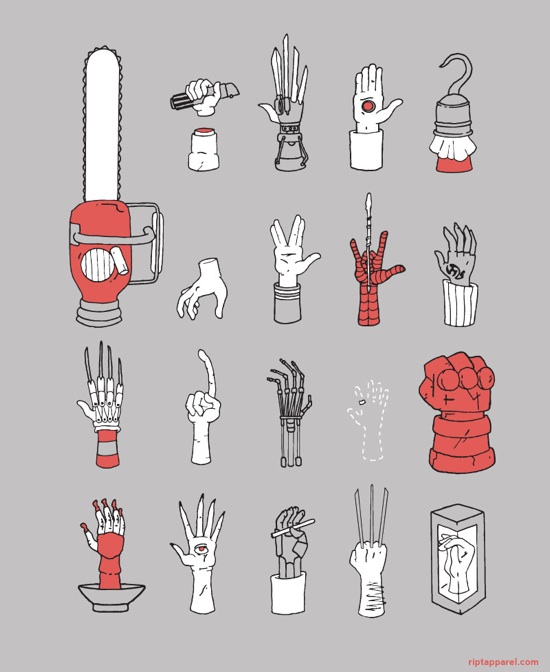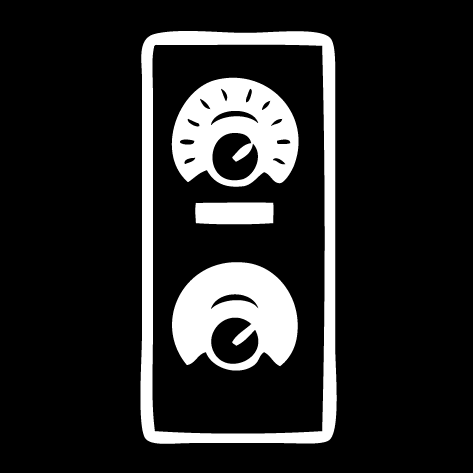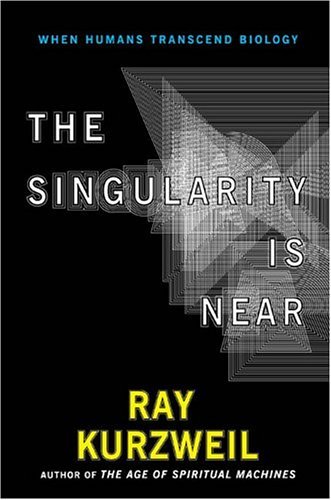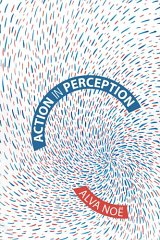books
Merleau-Ponty’s philosophy
On 24, Sep 2009 | 3 Comments | In books | By David Birnbaum
“Yes or no: do we have a body—that is, not a permanent object of thought, but a flesh that suffers when it is wounded, hands that touch?” — The Visible and the Invisible
Merleau-Ponty’s Philosophy by Lawrence Hass was the first full book I read on the great phenomenologist. If you’re fascinated by sensation, perception, synesthesia, metaphor, and flesh (and frankly, who isn’t?), please read it! It offers many wonderful revelations. I’ll briefly review the following topics from the book:
- Sensation/perception is a false dichotomy.
- Perception is “contact with otherness.”
- Synesthesia is a constant feature of experience.
- The concepts of “reversibility” and “flesh”
Tactility in the Tractatus Logico-Philisophicus
On 01, Jul 2009 | No Comments | In books | By David Birnbaum
I’ve written before about the later writings of Wittgenstein and the metaphor of the word as a manual tool. However, in Ludwig’s first published work, the Tractatus Logico-Philosophicus, his theory of language is that sentences represent states of affairs, the so-called picture theory of language. Although he later abandoned that viewpoint for the tool-based one, I was intrigued by this historically significant switch-up, so I read through the Tractatus with special attention to its visual and tactile metaphors. Here are a few examples.
2.013
Each thing is, as it were, in a space of possible states of affairs. This space I can imagine empty, but I cannot imagine the thing without the space.
2.0131
A spatial object must be situated in infinite space. (A spatial point is an argument-place.)
A speck in the visual field, though it need not be red, must have some colour: it is, so to speak, surrounded by colour-space. Notes must have some pitch, objects of the sense of touch some degree of hardness, and so on.
This is a prime example of a sensory metaphor used throughout the book. Objects are described in a visual way, as being seen as situated within a possibility space or belief space. They themselves have extension, but we perceive them as taking up some amount of the visual field (surrounded by context, which here is represented as other possibilities for their position or physical attributes).
2.151
Pictorial form is the possibility that things are related to one another in the same way as the elements of the picture.
2.1511
That is how a picture is attached to reality; it reaches right out to it.
2.1512
It is laid against reality like a measure.
2.15121
Only the end-points of the graduating lines actually touch the object that is to be measured.
Again we get a visual metaphor described in terms of physicality. How is a picture “attached” to reality? It reaches out to it. And while it touches reality, it only just touches it, in a tangential way. Wittgenstein starts with a visual image and then writes “attached”, “reaches out”, “laid against”, and “touch”—all haptic metaphors.
2.1514
The pictorial relationship consists of the correlations of the picture’s elements with things.
2.1515
These correlations are, as it were, the feelers of the picture’s elements, with which the picture touches reality.
Now we have moved from the picture as a “measure,” a passive geometry tool, to a picture as an agent. Not just any agent, but an agent with a capacity for haptic perception. What is a “feeler”? To me that word means a mobile extremity with sense organs which can be used to find out about the world. So, what Wittgenstein seems to be saying here is that when we generate a picture in our mind, it’s as if we are extending our hand into the world.
4.002
…
Language disguises thought. So much so, that from the outward form of the clothing it is impossible to infer the form of the thought beneath it, because the outward form of the clothing is not designed to reveal the form of the body, but for entirely different purposes.
In other words, thoughts are like physical objects. A word envelops a thought. We have a thought and then we toss a word-robe over it and shove it onto the stage of discourse where it can interface with other enrobed thoughts.
4.411
It immediately strikes one as probable that the introduction of elementary propositions provides the basis for understanding all other kinds of proposition. Indeed the understanding of general propositions palpably depends on the understanding of elementary propositions.
Once again, a tactile metaphor (“palpably”) is used for emphasis and to indicate comprehensive understanding.
5.557
…
What belongs to its application, logic cannot anticipate.
It is clear that logic must not clash with its application.
But logic has to be in contact with its application.
Therefore, logic and its application must not overlap.
I.e.,

Is “overlap” a haptic metaphor or a visual one? It could be either, or both.
6.432
How things are in the world is a matter of complete indifference for what is higher. God does not reveal himself in the world.
6.4321
The facts all contribute only to setting the problem, not to its solution.
6.44
It is not how things are in the world that is mystical, but that it exists.
6.45
To view the world sub specie aeterni is to view it as a whole—a limited whole.
Feeling the world as a limited whole—it is this that is mystical.
To feel is to know, silently, mystically.
I was pretty surprised at how easy it seems to foresee Wittgenstein’s turn from the eye to the hand. He presents what he calls a picture theory of language, but it repeatedly leads to a description of solid objects in space, or bodies moving and feeling and contacting each other. Of course I’m reading with a very biased perspective. Not only is my goal to hunt for tactile metaphors but I also know how the story ends some 30 years later. Still, I can’t help but feel that the tactile language in the Tractatus may foreshadow the shift to come.
The Hand
On 04, Jun 2009 | One Comment | In art, books, cognition, neuroscience, physiology, tactility | By David Birnbaum
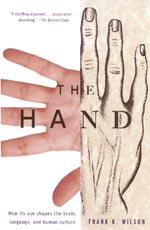 The Hand by Frank Wilson is a rare treat. It runs the gamut from anthropology (both the cultural and evolutionary varieties), to psychology, to biography. Wilson interviews an auto mechanic, a pupeteer, a surgeon, a physical therapist, a rock climber, a magician, and others—all with the goal of understanding the extent to which the human hand defines humanness.
The Hand by Frank Wilson is a rare treat. It runs the gamut from anthropology (both the cultural and evolutionary varieties), to psychology, to biography. Wilson interviews an auto mechanic, a pupeteer, a surgeon, a physical therapist, a rock climber, a magician, and others—all with the goal of understanding the extent to which the human hand defines humanness.
Wilson is a neurologist who works with musicians who have been afflicted with debilitating chronic hand pain. As he writes about his many interviews, a few themes emerge that are especially relevant to our interests here.
Incorporation
Incorporation is the phenomenon of internalizing external objects; it’s the feeling that we all get that a tool has become one with our body.
The idea of “becoming one” with a backhoe is no more exotic than the idea of a rider becoming one with a horse or a carpenter becoming one with a hammer, and this phenomenon itself may take its origin from countless monkeys who spent countless eons becoming one with tree branches. The mystical feel comes from the combination of a good mechanical marriage and something in the nervous system that can make an object external to the body feel as if it had sprouted from the hand, foot, or (rarely) some other place on the body where your skin makes contact with it…
The contexts in which this bonding occurs are so varied that there is no single word that adequately conveys either the process or the many variants of its final form. One term that might qualify is “incorporation”—bringing something into, or making it part of, the body. It is a commonplace experience, familiar to anyone who has ever played a musical instrument, eaten with a fork or chopsticks, ridden a bicycle, or driven a car. (p. 63)
Projection
Projection is the ability to use the hand as a bridge for projecting consciousness from one location to another. (Wilson did not use the word “projection” in the book.) In some ways, projection can be seen as the opposite of incorporation. Master puppeteer Anton Bachleitner:
It takes at least three years of work to say you are a puppeteer. The most difficult job technically is to be able to feel the foot contact the floor as it actually happens. The only way to make the puppet look as though it is actually walking is by feeling what is happening through your hands. The other thing which I think you cannot really train for, but only can discover with very long practice and experience, is a change in your own vision.The best puppeteer after some years will actually see what is happening on the stage as if he himself was located in the head of the puppet, looking out through the puppet’s eyes—he must learn to be in the puppet. This is true not only in the traditional actor’s sense, but in an unusual perceptual sense. The puppeteer stands two meters above the puppet and must be able to see what is on the stage and to move from the puppet’s perspective. Moving is a special problem because of this distance, because the puppet does not move at the same time your hand does. Also, there can be several puppets on the stage at the same time, and to appear realistic they must react to each other as they would in real life. So again the puppeteer must himself be mentally on the stage and able to react as a stage actor would react. This is something I cannot explain, but it is very imprortant for a puppeteer to be able to do this. (pp. 92–93)
Serge Percelly, professional juggler:
[An act is successful] not because you put something in the act that’s really difficult, but because you put something in the act in exactly the right way—in a way that makes it more interesting, not only for me but for the audience as well. I’m just trying somehow to do the act that I would have loved to see. (p. 111)
Skill
Wilson is a musician and a doctor to musicians, so he has special insight into the neurology of musical skill—which he recognizes as special case of manual skill that involves gesture, communication, and emotion.
Musical skill provides the clearest example and the cleanest proof of the existence of a whole class of self-defined, personally distinctive motor skills with an extended training and experience base, strong ties to the individual’s emotional and cognitive development, strong communicative intent, and very high performance standards. Musical skill, in other words, is more than simply praxis, ordinary manual dexterity, or expertness in pantomime. (p. 207)
The upper-limb (or “output”) requirements for an instrumentalist are not unique either; they depend upon the possession of arms, fingers, and thumbs, specific but idiosyncratic limits on the rage of motion at the shoulder, elbow, wrist, hand, and finger joints, variable abilities to achieve repetition rates and forces with specific digital configurations in sequence at multiple contact points on a sound-making device, and so on. Peculiarities in the physical configuration and movement capabisities of the musician’s limbs can be an advantage or disadvantage but are reflected in (and in adverse cases can be overcome through) instrument design: How wide can you make the neck of a guitar? How far apart should the keys be on a piano? Where should the keys be placed on a flute—in general? and for Susan and Peter? (p. 225)
Awareness
Touch experience can be a gateway to awareness, which can in turn heal both the mind and the body. Moshe Feldenkrais invented a form of physical therapy that focuses on stimulating an awareness of touch and movement sensations in order to relieve pain.
Most people slouch, tilt, shuffle, twist, stumble, and hobble along. Why should that be? Was there something wrong with their brains? After considering what dancers and musicians go through to improve control of their movements, [Feldenkrais] guessed that people must either be ignorant of the possibilities or refuse to act on them. So they just heave themselves around, lurching from parking place to office to parking place, utterly oblivious to what they are doing, to their appearance, and even to the sensations that arise from bodily movement. He suspected that people just lose contact with their own bodies. If and when they do notice, it is because they are so stiff that they can’t get out of bed or are in so much pain that they can barely get out of a chair. Then they start noticing…
What [Feldenkrais] was doing did not seem complicated. The goal of the guided movements was not to learn how to move, in the sense of learning to do a new dance step. The goal was not to stretch ligaments or muscles. It was not to increase strength. The goal, as he saw it, was to get the messages moving again and to encourage the brain to pay attention to them. (p. 244)
And his student, Anat Baniel, on the deep psychological roots of movement disorders:
I think working with children has given me this idea, which isn’t often discussed in medicine: a lot of disease—medical disease and emotional “dis-ease”—is an outcome of a lack of full development. It’s not something we can get to just by removing a psychological block…
Of course there are problems due to traumatic events in childhood, or disease—you name it. Feldenkrais said that ideal development would happen if the child was not opposed by a force too big for its strength. When you say to a small child, “Don’t touch that, it’s dangerous!” you create such a forceful inhibition that you actually distort the child’s movement, and growth, in a certain way.
Feldenkrais taught us to look for what isn’t there. Why doesn’t movement happen in the way that it should, given gravity, given the structure of the body, given the brain? For all of us there is a sort of sphere, or range, of movement that should be possible. Some people get only five or ten percent of that sphere, and you have to ask, “What explains the difference between those who get very little and those who get a lot?” Feldenkrais said that the difference is that in the process of development, the body encountered forces that were disproportionate to what the nervous system could absorb without becoming overinhibited—or overly excited, which is a manifestation of the same thing. (p. 252)
Feldenkrais’s approach is fascinating, but there is scant discussion in Wilson’s book about the role of the therapist’s hand in this process. After all, this kind of therapy is wholly reliant on an accidental discovery: that the patient can be made aware of her own body through an external, expert hand radiating pressure and heat. How is this possible? The topic isn’t explored.
There are many, many wonderful things to learn from this book for anyone with an interest in biology, art, music, history, or sports. You can find Frank Wilson on the web at Handoc.com
Embodied music cognition
On 08, Oct 2008 | No Comments | In books, cognition, music, neuroscience | By David Birnbaum
 This is Your Brain on Music is a great introductory book on the neuroscience of music. Although I found it weighted a bit too much toward popular science for my liking, that was its stated purpose, and there was still plenty of good information in it.
This is Your Brain on Music is a great introductory book on the neuroscience of music. Although I found it weighted a bit too much toward popular science for my liking, that was its stated purpose, and there was still plenty of good information in it.
Here we have an explanation of musical timing as an analogy for a moving body:
Virtually every culture and civilization considers movement to be an integral part of music making and listening. Rhythm is what we dance to, sway our bodies to, and tap our feet to… It is no coincidence that making music requires the coordinated, rhythmic use of our bodies, and that energy be transmitted from body movements to a musical instrument. (57)
‘Tempo’ refers to the pace of a musical piece—how quickly or slowly it goes by. If you tap your foot or snap your fingers in time to a piece of music, the tempo of the piece will be directly related to how fast or slow you are tapping. If a song is a living, breathing entity, you might think of the tempo as its gait—the rate at which it walks by—or its pulse—the rate at which the heart of the song is beating. The word ‘beat’ indicates the basic unit of measurement in a musical piece; this is also called the ‘tactus’. Most often, this is the natural point at which you would tap your foot or clap your hands or snap your fingers. (59)
Levitin also delves into the possible evolutionary reasons for music, noting that music seems to always go with dance, and that the concept of the expert musical performer is very recent:
When we ask about the evolutionary basis for music, it does no good to think about Britney or Bach. We have to think about what music was like around fifty thousand years ago. The instruments recovered from archeological sites can help us understand what our ancestors used to make music, and what kinds of melodies they listened to. Cave paintings, paintings on stoneware, and other pictorial artifacts can tell us something about the role that music played in daily life. We can also study contemporary societies that have been cut off from civilization as we know it, groups of people who are living in hunter-gatherer lifestyles that have remained unchanged for thousands of years. One striking find is that in every society of which we’re aware, music and dance are inseparable.The arguments against music as an adaptation consider music only as disembodied sound, and moreover, as performed by an expert class for an audience. But it is only in the last five hundred years that music has become a spectator activity—the thought of a musical concert in which a class of “experts” performed for an appreciative audience was virtually unknown throughout our history as a species. And it has only been in the last hundred years or so that the ties between musical sound and human movement have been minimized. The embodied nature of of music, the indivisibility of movement and sound, the anthropologist John Blacking writes, characterizes music across cultures and across times. (257)
I agree. Even though we may use modern technology to exploit musical cognitive faculties for maximum effect, the idea that music/dance is a counter-evolutionary accident seems wrong to me.
You can find the website that accompanies the book at yourbrainonmusic.com.
Philosopher deathmatch, and how words are like tools
On 07, Sep 2008 | No Comments | In books, language, tactility | By David Birnbaum
 I just finished reading Wittgenstein’s Poker. From the jacket:
I just finished reading Wittgenstein’s Poker. From the jacket:
In October 1946, philosopher Karl Popper arrived at Cambridge to lecture at a seminar hosted by his legendary colleague Ludwig Wittgenstein. It did not go well: the men began arguing, and eventually, Wittgenstein began waving a fire poker toward Popper. It lasted scarcely 10 minutes, yet the debate has turned into perhaps modern philosophy’s most contentious encounter, largely because none of the eyewitnesses could agree on what happened. Did Wittgenstein physically threaten Popper with the poker? Did Popper lie about it afterward?
The authors provide a comprehensive biographical and historical context for the incident, and use it as a springboard into the two men’s respective philosophies. It’s an enjoyable look at two self-important, short-tempered intellectuals and their rivalry.
As I mentioned in this post, I find Wittgenstein’s philosophy of language often invokes touch themes. In the following excerpt from Poker (originating from one of his lectures), Wittgenstein makes a point about a colleague’s statement, “Good is what is right to admire,” utilizing a haptic metaphor:
The definition throws no light. There are three concepts, all of them vague. Imagine three solid pieces of stone. You pick them up, fit them together and you now get a ball. What you’ve now got tells you something about the three shapes. Now consider you have three balls of soft mud or putty. Now you put the three together and mold out of them a ball. Ewing makes a soft ball out of three pieces of mud. (68)
Another example stems from Wittgenstein’s midlife change in philosophical outlook. In his first publication, the Tractatus Logicio-Philosophicus, he was preoccupied with the “picture theory of language”—the idea that sentences describe “states of affairs” that can be likened to the contents of a picture. Later, he developed a theory of language based on words as tools for conveying meaning. In my reading, he shifted from a vision-based to a haptic-based (in fact, a distinctly physical-interaction-based) understanding of how language works.
The metaphor of language as a picture is replaced by the metaphor of language as a tool. If we want to know the meaning of a term, we should not ask what it stands for: we should instead examine how it is actually used. If we do so, we will soon recognize that there is no underlying single structure. Some words, which at first glance look as if they perform similar functions, actually operate to distinct sets of rules. (229)
Here’s the relevant passage directly from Philisophical Investigations:
It is like looking into the cabin of a locomotive. We see handles all looking more or less alike. (Naturally, since they are all supposed to be handled.) But one is the handle of a crank which can be moved continuously (it regulates the opening of a valve); another is the handle of a switch, which has only two effective positions, it is either off or on; a third is the handle of a brake-lever, the harder one pulls on it, the harder it brakes; a fourth, the handle of the pump: it has an effect only so long as it is moved to and fro. (PI, I, par. 12)
Words as the physical interface to meaning. Love it!
Wittgenstein
On 28, May 2008 | One Comment | In books, tactility | By David Birnbaum
 The philosophy of Ludwig Wittgenstein seems to come up often, so I decided to read up on what all the hoopla is about. This semi-biographical introduction to his major works is fascinating and easy to read. It seemed pretty comprehensive as well, though I’m no expert.
The philosophy of Ludwig Wittgenstein seems to come up often, so I decided to read up on what all the hoopla is about. This semi-biographical introduction to his major works is fascinating and easy to read. It seemed pretty comprehensive as well, though I’m no expert.
Wittgenstein was primarily concerned with logic and language, but I found his emphasis on know-how as opposed to know-that, and his view that skill supersedes knowledge of rules, to have a certain ‘embodiment’ quality to it. Excerpts:
So, language can indeed be said to be governed by rules; but those rules are for the most part only implicit in native speakers’ common usage. They can be derived from common usage by anyone who pays attention to it, but they are rarely operative in it: we do not normally use rules to work out what is correct. Rather, we have a fairly reliable ‘feeling’ for what sounds right in a given case. Rules can be formulated to codify our usage, but our usage is not ultimately based on such rules. (191)
Our traditional concept of pain, however, is not in competition with concepts that classify the same phenomena in terms of their underlying conditions. No physiologist could convince me that what in my own case I call ‘pain’ may not in fact be pain, or that my pain was in truth not where I felt it but in the brain. Why is this so?
Concepts are an expression of our interests. We group things together and call them by a common name according to those resemblances we find striking or important. And in different contexts we may be interested in different aspects of things. To classify phenomena scientifically, by their underlying structures or causes, is not always what we want. For instance, when taking an aesthetic attitude towards things, we are concerned entirely with their appearances. Invisible micro-structures become wholly irrelevant. And another area in which the scientific urge to leave behind the surface for underlying causes is often out of place is the realm of feeling: where our primary interest is in people’s conscious experience. Their suffering and well-being is important to us in its own right, and not merely as an indication of some underlying physiological conditions. Therefore physiological concepts like ‘lesion of tissue’ — whatever their importance for diagnosis and therapy — can never be in competition with, or act as substitutes for, our traditional concepts of feelings and emotions that are taught and understood through their links with natural expressive behaviour and characterized by the special authority we have in their first-person use. (254)
Singulatarianism
On 18, Apr 2008 | No Comments | In books | By David Birnbaum
Ray Kurzweil’s The Singularity Is Near is worth reading. It’s a great introduction to the “emerging technologies” meme. If you’ve already begun wandering down the diabolical path of contemplating the obsolescence of biology and the societal transformation that will result, Singularity doesn’t reveal much. However it’s an easy read and a cultural milestone, so pushing through it is still probably a good idea.
That said, I had a few gripes with the book. Firstly, the author’s tone doesn’t sound like the cool scientific theorist he claims to be. Virtually every discussion of progress in biotechnology lends particular weight to the synthesizing of artificial pancreas cells, which Kurzweil readily acknowledges he needs to reverse the course of his diabetes. He repeats over and over that people (like him) who take full advantage of today’s knowledge about longevity will live to see the Singularity (and by corollary, live indefinitely), and that those who do not will needlessly pay the price of annihilation. I don’t remember even one acknowledgment that his own efforts may fail (or be misguided!) despite his dogged adherence to health guidelines derived from cutting edge research. This doesn’t seem to reflect the attitude of a detached intellectual.
Maybe I’m being too harsh. It’s pretty clear that Kurzweil tries to make his subject singularly exciting, and the book seems to be written at least partially for the journalists who might like to capitalize on the author’s theory by writing articles to the effect of, “This man says you’ll socialize with robots one day. Isn’t that insane plus totally interesting?”
Still, I found his discussions of sociology and morality hugely lacking. Kurzweil falls far short in his brief examination of the coming collisions between the Singularity and virtually every modern social structure. He might counter that his goal for the book was to cultivate optimism and open minds to the grand potential of the coming transcendence. But with its foreboding title, one would expect the book to not only open minds but also put them on guard against perversions of his grand vision. And for his slight allowance that catastrophe may wipe us all out before (or after) the Singularity, he does not explicitly acknowledge that our place in the universe is so absurdly minute that, for instance, even after our entire solar system becomes a giant computer the collision of two unknown (or even known) neutron stars halfway across our galaxy could fry it all, and human technology might be powerless to stop it.
I extracted some passages that were relevant to haptics:
The current disadvantages of Web-based commerce (for example, limitations in the ability to directly interact with products and the frequent frustrations of interacting with inflexible menus and forms instead of human personnel) will gradually dissolve as the trends move robustly in favor of the electronic world. By the end of this decade, computers will disappear as distinct physical objects, with displays built in our eyeglasses and electronics woven in our clothing, providing full-immersion visual virtual reality. Thus, “going to a Web site” will mean entering a virtual-reality environment—at least for the visual and auditory senses—where we can directly interact with products and people, both real and simulated… Haptic (tactile) interfaces will enable us to touch products and people. It is difficult to identify any lasting advantage of the old brick-and-mortar world that will not ultimately be overcome by the rich interactive interfaces that are soon to come. (104–105)
I don’t like “haptic (tactile)” (they’re not equivalent), but the point is clear. There were also some references to musical interaction research:
Edward Taub at the University of Alabama studied the region of the cortex responsible for evaluating the tactile input from the fingers. Comparing non-musicians to experienced players of stringed instruments, he found no difference in the brain regions devoted to the fingers of the right hand but a huge difference for the fingers of the left hand. (174)
Dr. Alvaro Pascual-Leone at Harvard University scanned the brains of volunteers before and after they practiced a simple piano exercise. The brain motor cortex of the volunteers changed as a direct result of their practice. He then had a second group just think about doing the piano exercise but without actually moving any muscles. This produced an equally pronounced change in the motor-cortex network. (175)
Finally, I think the use of the word “mastering” here brings up an important point:
Machines have exacting memories. Contemporary computers can master billions of facts accurately, a capability that its doubling every year. (261)
Haptic metaphors like this are used generously throughout the book, no doubt to underscore Kurzweil’s intense belief that humanity is ingrained in nonbiological intelligent technology. However, as a terminology freak I would argue that computers memorize facts, but don’t master them. Mastery comes with an ability to manipulate freely. For mastery, you need a body.
Enactive perception
On 27, Feb 2008 | No Comments | In books | By David Birnbaum
I just finished Action In Perception by Alva Noë. It’s a very readable introduction to the enactive view of perceptual consciousness, which argues that perception neither happens in us nor to us; rather, it’s something we do with our bodies, situated in the physical world, over time. Our knowledge of the way in which sensory stimulation varies as we control our bodies is what brings experience about. Without sensorimotor skill, a stimulus cannot constitute a percept. Noë presents empirical evidence for his claim, drawing on the phenomenology of change blindness as well as tactile vision substitution systems. I highly recommend the book.
The emphasis on embodied experience leads to the use of touch as a model for perception, rather than the traditional vision-based approach. Here’s an excerpt:
Touch acquires spatial content—comes to represent spatial qualities—as a result of the ways touch is linked to movement and to our implicit understanding of the relevant tactile-motor dependencies governing our interaction with objects. [Philosopher George Berkeley] is right that touch is, in fact, a kind of movement. When a blind person explores a room by walking about in it and probing with his or her hands, he or she is perceiving by touch. Crucially, it is not only the use of the hands, but also the movement in and through the space in which the tactile activity consists. Very fine movements of the fingers and very gross wanderings across a landscape can each constitute excercises of the sense of touch. Touch, in all such cases, is movement. (At the very least, it is movement of something relative to the perceiver.) These Berkeleyan ideas form a theme, more recently, in the work of [Brian O'Shaughnessy's book "Consciousness and World"]. He writes: “touch is in a certain respect the most important and certainly the most primordial of the senses. The reason is, that it is scarely to be distinguished from the having of a body that can act in physical space”…But why hold that touch is the only active sense modality? As we have stressed, the visual world is not given all at once, as in a picture. The presence of detail consists not in its representation now in consciousness, but in our implicit knowledge now that we can represent it in consciousness if we want, by moving the eyes or by turning the head. Our perceptual contact with the world consists, in large part, in our access to the world thanks to our possession of sensorimotor knowledge.
Here, no less than in the case of touch, spatial properties are available due to links to movement. In the domain of vision, as in that of touch, spatial properties present themselves to us as “permanent possibilities of movement.” As you move around the rectangular object, its visible profile deforms and transforms itself. These deformations and transformations are reversible. Moreover, the rules governing the transformation are familiar, at least to someone who has learned the relevant laws of visuomotor contingency. How the item looks varies systematically as a function of your movements. Your experience of it as cubical consists in your implicit understanding of the fact that the relevant regularity is being observed.
Virtual and augmented reality interface design practices have already begun to demonstrate these concepts. Head mounted augmented reality displays sense the user’s eye and body movements to construct virtual percepts. Head related transfer functions (HRTFs) synthesize sound as it would be heard by an organism with certain physical characteristics, in a particular environment. It seems to me that an important implication for enactive interface design is that haptic sensory patterns can lead to perceptual experience in all sensory modes (vision, hearing, touch). Thus, all human-computer interaction/user experience can be viewed in a haptic context.

